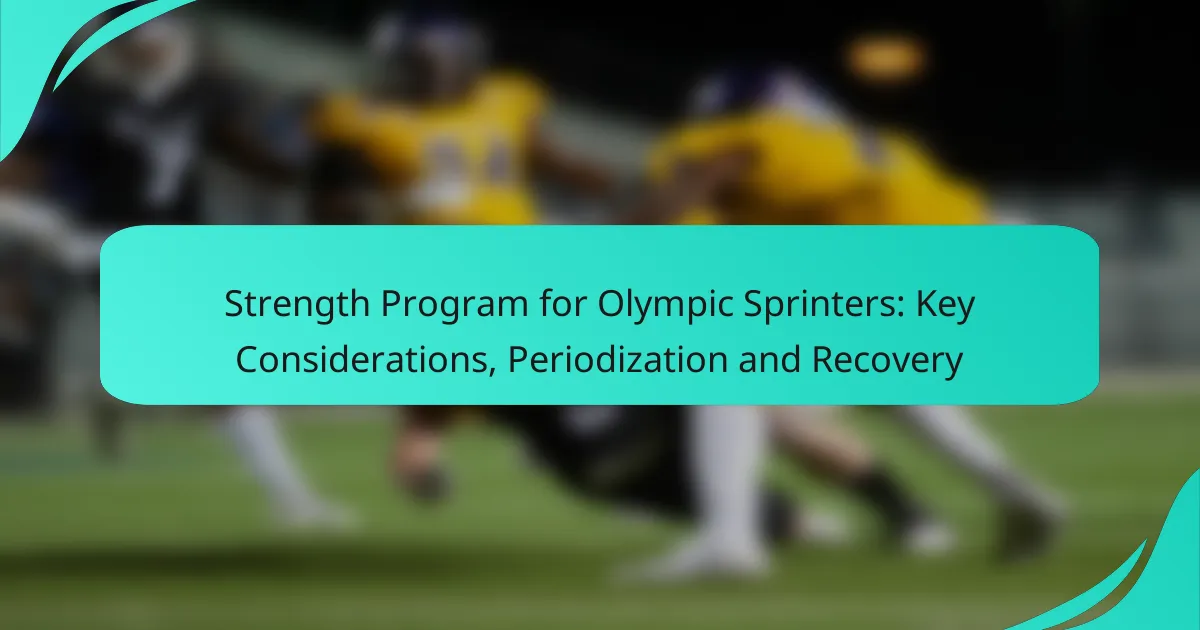Strength training for Olympic sprinters is vital for developing explosive power, muscle hypertrophy, and optimal biomechanics, all of which contribute to improved sprint performance and reduced injury risk. A well-structured periodization plan is essential, allowing for variations in training intensity and volume to maximize performance while ensuring adequate recovery. Additionally, implementing effective recovery strategies, including active recovery, proper sleep, and physiotherapy, is crucial for maintaining peak athletic condition and preventing injuries.

What are the key considerations for strength training in Olympic sprinters?
Key considerations for strength training in Olympic sprinters include the development of explosive strength, muscle hypertrophy, and proper biomechanics. These elements are crucial for enhancing sprint performance and minimizing injury risk.
Importance of explosive strength
Explosive strength is vital for sprinters as it directly affects their acceleration and top speed. This type of strength enables athletes to generate maximum force in minimal time, which is essential during the initial phases of a sprint.
Training methods such as plyometrics, Olympic lifts, and sprint drills can enhance explosive strength. Incorporating exercises like box jumps or power cleans can lead to significant improvements in sprinting performance.
Role of muscle hypertrophy
Muscle hypertrophy contributes to the overall strength and power of sprinters, allowing for greater force production. While sprinters typically prioritize explosive strength, a certain level of muscle growth is necessary to support their training demands.
Resistance training focusing on compound movements, such as squats and deadlifts, can promote hypertrophy. Athletes should aim for moderate repetitions with heavier weights to strike a balance between size and explosiveness.
Impact of biomechanics
Biomechanics plays a crucial role in sprinting efficiency and performance. Proper technique can optimize force application and minimize energy wastage, leading to faster sprint times.
Sprinters should focus on their running form, including posture, stride length, and arm movement. Regular video analysis and feedback can help identify areas for improvement and ensure that athletes maintain optimal mechanics during training and competition.
Nutrition and supplementation
Nutrition is a cornerstone of effective strength training for sprinters. A well-balanced diet rich in carbohydrates, proteins, and healthy fats supports energy needs and muscle recovery.
Supplementation can also play a role, particularly with protein powders or creatine, which may aid in muscle recovery and growth. Athletes should consult with a sports nutritionist to tailor their diet and supplementation to their specific training goals.
Injury prevention strategies
Injury prevention is essential for sprinters to maintain consistent training and performance levels. Implementing a comprehensive warm-up routine, including dynamic stretches and mobility exercises, can reduce the risk of injuries.
Additionally, incorporating strength training that focuses on stabilizing muscles and improving flexibility can help prevent common sprinting injuries. Athletes should also prioritize recovery strategies, such as rest days and active recovery sessions, to support long-term health.

How to implement periodization in strength programs for sprinters?
Implementing periodization in strength programs for sprinters involves systematically varying training intensity and volume to optimize performance and recovery. This structured approach helps athletes peak at the right time while minimizing the risk of injury and overtraining.
Types of periodization models
There are several types of periodization models, including linear, non-linear, and block periodization. Linear periodization gradually increases intensity while decreasing volume over time, making it suitable for beginners. Non-linear periodization allows for more frequent variations in intensity and volume, catering to advanced athletes who require more flexibility in their training. Block periodization focuses on specific training blocks, emphasizing distinct physical qualities like strength or speed.
Macrocycle, mesocycle, and microcycle breakdown
Periodization is typically divided into three levels: macrocycle, mesocycle, and microcycle. A macrocycle spans an entire training year, encompassing all phases leading to peak performance. Mesocycles last several weeks to months, focusing on specific training goals, such as strength or power. Microcycles are the shortest, usually lasting a week, detailing daily workouts and recovery strategies.
Adjusting volume and intensity
Adjusting volume and intensity is crucial in periodization. Volume refers to the total amount of work done, while intensity pertains to the difficulty of the exercises. For sprinters, a common approach is to start with higher volume and lower intensity during base training, then gradually shift to lower volume and higher intensity as competition approaches. A practical guideline is to maintain a volume of 60-80% during strength phases and reduce it to 40-60% during peak phases, ensuring adequate recovery and performance gains.

What recovery strategies are effective for Olympic sprinters?
Effective recovery strategies for Olympic sprinters include active recovery techniques, prioritizing sleep and rest, and utilizing physiotherapy and massage. These methods help reduce fatigue, enhance performance, and prevent injuries, ensuring athletes can train and compete at their best.
Active recovery techniques
Active recovery techniques involve low-intensity exercises that promote blood flow and aid in muscle recovery. Activities such as light jogging, cycling, or swimming for 20-30 minutes can help flush out lactic acid and reduce soreness. Incorporating these sessions into training schedules can enhance overall recovery without adding significant fatigue.
Additionally, dynamic stretching and mobility work can be beneficial post-training. These activities help maintain flexibility and range of motion, which are crucial for sprinters. Aim for 2-3 active recovery sessions per week, especially following intense workouts or competitions.
Importance of sleep and rest
Sleep and rest are critical components of recovery for Olympic sprinters. Quality sleep, ideally 7-9 hours per night, supports muscle repair, hormone regulation, and cognitive function. Athletes should establish a consistent sleep schedule and create a restful environment to maximize their recovery.
Rest days are equally important, allowing the body to recover from the cumulative stress of training. Incorporating at least one full rest day per week can help prevent overtraining and reduce the risk of injuries. Listening to the body and adjusting training intensity based on fatigue levels is essential for optimal performance.
Role of physiotherapy and massage
Physiotherapy and massage play a significant role in the recovery process for sprinters. Regular sessions with a physiotherapist can help identify and address any muscular imbalances or injuries before they become severe. Techniques such as dry needling or ultrasound therapy may also be employed to enhance recovery.
Massage therapy can alleviate muscle tension, improve circulation, and promote relaxation. Athletes should consider scheduling massages after intense training sessions or competitions, ideally once a week, to facilitate recovery. Combining these therapies with other recovery strategies can lead to improved performance and longevity in the sport.

How does strength training differ for sprinters compared to other athletes?
Strength training for sprinters focuses on developing explosive power and speed, which differs significantly from the endurance and strength emphasis seen in other athletes. Sprinters require specific training regimens that enhance their ability to generate force quickly, optimizing their performance in short bursts of high-intensity effort.
Specificity of training for speed
Training for speed involves exercises that prioritize fast-twitch muscle fibers, which are crucial for sprinting. This includes movements like Olympic lifts, plyometrics, and sprint drills that enhance acceleration and top speed. A typical strength program may incorporate low-rep, high-weight sets to build maximum strength, followed by explosive movements to translate that strength into speed.
For optimal results, sprinters should aim for strength training sessions that last around 60-90 minutes, focusing on compound lifts such as squats and deadlifts. Incorporating sprint-specific drills, like resisted sprints or hill sprints, can further enhance speed development.
Comparison with distance runners
Distance runners generally focus on building endurance and aerobic capacity, which leads to different strength training needs. Their programs often emphasize higher repetitions with lower weights to enhance muscular endurance, contrasting with the low-rep, high-intensity approach favored by sprinters.
While distance runners may include strength training to prevent injury and improve overall performance, their workouts typically prioritize stamina over explosive power. For sprinters, the goal is to maximize speed and power output, which requires a tailored approach that emphasizes short, intense bouts of strength work rather than prolonged endurance training.

What are the common mistakes in strength training for sprinters?
Common mistakes in strength training for sprinters include neglecting flexibility, focusing too much on strength without considering speed, and improper recovery practices. These errors can hinder performance and increase the risk of injury.
Neglecting flexibility training
Flexibility training is often overlooked by sprinters, yet it plays a crucial role in overall performance and injury prevention. Insufficient flexibility can limit range of motion, affecting stride length and speed during races.
Incorporating flexibility exercises, such as dynamic stretches and mobility drills, into a training regimen can enhance muscle elasticity and joint function. Aim for flexibility sessions at least 2-3 times per week, focusing on major muscle groups used in sprinting, like the hamstrings, quadriceps, and hip flexors.
Common pitfalls include static stretching before sprinting, which can temporarily reduce power output. Instead, prioritize dynamic stretches that prepare the muscles for explosive movements. Consider using foam rollers or massage techniques to improve muscle recovery and flexibility as well.
